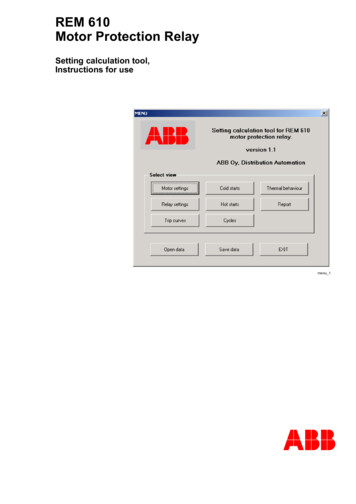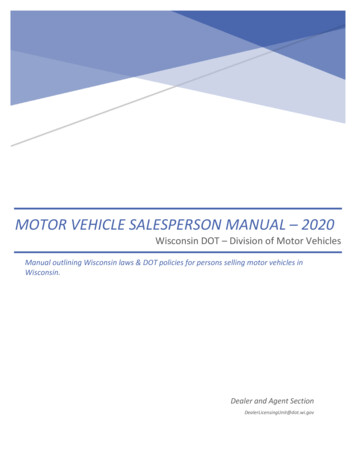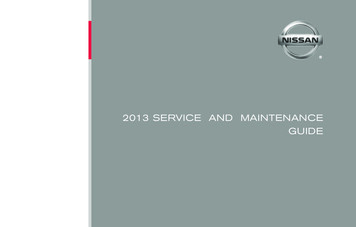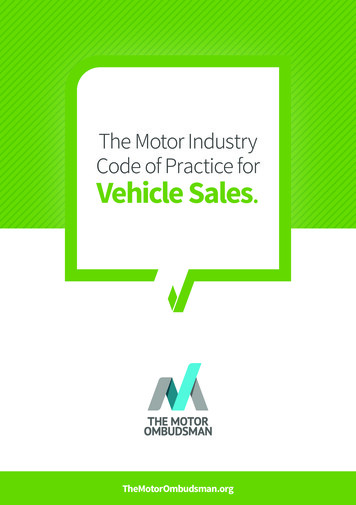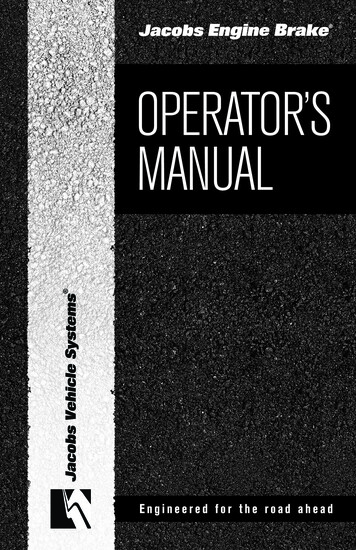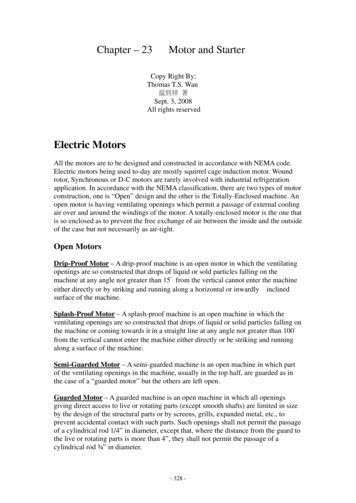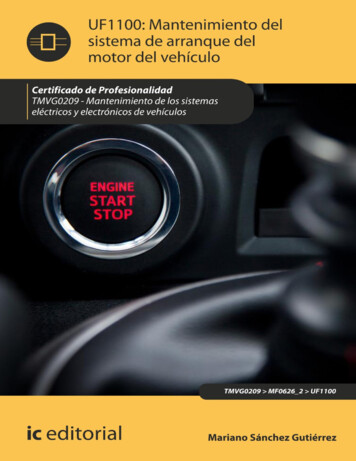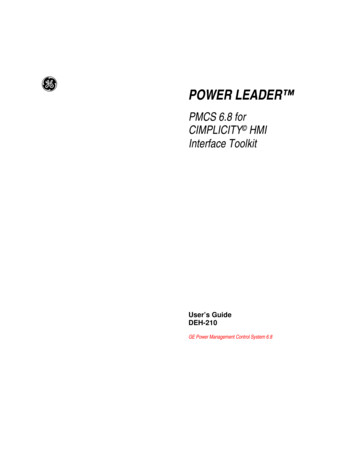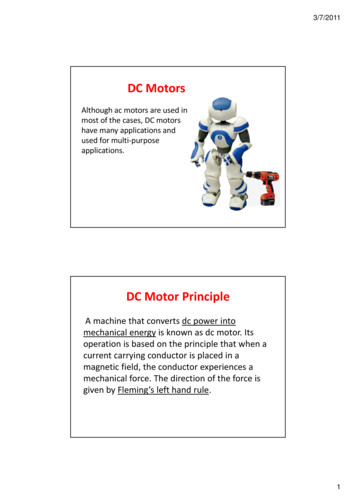
Transcription
Motor Vehicle Systems,Maintenance, Safety Devices,and Performance CapabilitiesHED 302s – Driver Task AnalysisDale O. Ritzel, Ph.D., FAASE
Preventive Vehicle Maintenance – theworksheets in this topic area will help you keepyour vehicle in good condition. Tires Cooling Fluids Suspension Visibility System
Vehicle Systems Engine/Drive Train– In-line mounting: rear-wheel drive, 4-wheeldrive– Transverse mounting: front-wheel drive,all-wheel drive– Mid-engine mounting: rear-wheel drive– Rear-engine mounting: rear-wheel drive
Vehicle Systems Fuel system– Electronic fuel injection (EFI)– Carburetor Electrical butor ignitionElectronic ignitionComputer vs. current regulatorElectronic traction control
Vehicle Systems Exhaust system Lubricating and cooling systems Suspension system– Shock and spring– McPherson strut
Vehicle Systems – view the vehiclesystems review and assignment page tolearn more about vehicle systems. Steering––––Full powerPower assistedRack and pinionSteering wheel size and response Braking––––Drum and shoeCaliper discAnti-lockTraction control
Vehicle MaintenanceProblem AreasTiresOil LevelDrive BeltsEmissionsLights OutBatteryVehicles nt42.5%29.7%29.0%25.0%24.1%20.5%Vehicles Tested: 134,650 in the following states: VA, NY, TX, WA,MO, IN, OH, KY, MD, NJ, LA, NE, SC, AL, CO, PA, NH, RI, OK,MN, GA, NC, VT, TN, DC, and WY
Tires Selection Inflation Rotation Alignment Balance Sidewall InformationReview the tire information on the Web siteshown on the main Web page for the course.
Lubrication System The lubricating system reduces heat by coatingthe engine parts with oil. Coating engine partswith oil reduces friction, heat, and wear. Oilalso helps clean internal engine surfaces andprevent rust and corrosion. Change your oiland oil filter every 3000 miles or every 6months, whichever comes first. An oil pump moves oil from the oil pan to allmoving engine parts. The oil filter cleans theoil as it circulates. Grease is used to lubricate parts of the car,such as the steering system. Grease reducesfriction.
Cooling Systems The purpose of the cooling system is to keepyour car’s engine from overheating. Thecooling system circulates coolant (usually amixture of water and antifreeze) through theengine by means of a network of pipes,channels, and connecting hoses. The coolant is stored in the radiator andradiator overflow tank. A water pump movesthe coolant through the radiator and thecirculating network. A thermostat works tocontrol the flow of coolant to maintain bestoperating temperature.
Visibility Systems Headlights and turn signals [keep them clean] Window glass [keep them clean] Wipers and cleaning solutions [have goodworking wipers, replacing them regularly andkeep a good supply of fluid in your windowwashing container. Defrosters
Maintenance ChecklistsTypical Inspections that a driver should do:–––––––––Suspension on Yearly BasisWindshield Wipers on Monthly BasisHeadlights and Other Lights on Weekly BasisTire Pressure and Wear on Weekly BasisFluid Levels on Weekly BasisWindow Glass on Daily BasisBrake Function on Daily BasisSteering Function on Daily BasisExhaust System on Daily Basis
Maintenance ChecklistsTypical Service Inspections as per Owner’s Manual– Engine System Tuning– Cooling System Service– Oil Change and Lubrication Service– Transmission/Trans axle Service– Brake Service– Air Conditioning Service– Alignment and Tire Rotation ServiceREAD YOUR VEHICLE OWNERS’ MANUAL. Beone of the few that does read the manual.
Vehicle Performance Acceleration & Speed Holding CapabilityDirectional Control and StabilitySlowing and BrakingLoad CapacitySkid Resistance and RecoveryVisibility-Blind Spots-Mirror Adjustment [do youknow the best way to adjust your outside mirrors? Ifnot, ask your instructor. You are providing notmaximizing your visibility to the rear] Seat Adjustment & Ease of Entry and Exit
Acceleration and SpeedHolding Capability Acceleration, deceleration, and speed can helpyou judge time and space. Rate of acceleration is the time it takes toaccelerate from one speed to another. Deceleration rate is the time it takes to go fromone speed to another. Generally large cars with high horsepowerhave good acceleration and can maintain speedbetter than under-powered subcompact cars.
Directional Control andStability Under steer Over steer Recovery– Visual Control– Motion Control– Steering ControlDo you know what these terms mean? If not do asearch on the internet and define them for yourself.Knowing what the meaning of each will help youavoid a crash.
Slowing and Braking Downshifting– Front-wheel drive and Constant Velocity Joints– Rear-wheel Drive and Universal Joints Brake Application– Controlled Squeeze– Trail– Threshold– Lock– Stab/Jab (ABS)Review a current driver education textbook or carmagazine to learn about the above terminology.
Things to Consider "Load Capacity"Skid Resistance and "Recovery"Visibility – Blind Spots – Mirror Adjustment"Seat Adjustment"Ease of entry and Exit[Do you know what all of the factors mean? Ifnot you might want to read about theirmeaning.]
Safety Devices Passive RestraintsActive RestraintsDoor LocksSide guard door beamsDaytime Running LightsAnti-lock BrakesTraction Control Devices
Types of Safety Restraints Passive ( Automatic )– Automatic Belts and Bolsters– Airbags and Automatic Safety Belts Active ( Manual )––––Lap BeltsShoulder BeltsCombination Belts (3 point/Door Mounted)Child Restraints
Occupant ProtectionWhat Are Your State Law Requirements? [review thisinformation at the Illinois Secretary of State Web site]–––––Safety Restraint BenefitsIncreased Vehicle ControlOccupant Death ReductionDisabling Injury ReductionMinor Injury ReductionReduce Child Related Distractions
Occupant ProtectionShoulder Belt Mount Head Restraint AirbagFacts and Myths Ejection Fire and Immersion Child on Lap Point of ImpactMovement
Movement of Belted OccupantHead1.9 feet in 30 mph crashChest1.3 feet in 30 mph crashPelvis1.2 feet in 30 mph crashBased on 150-180 lb. male data
Belt Loading and FitCar Loaded Locking SystemsBelt Loaded Locking SystemsProper Adjustment
Safety Devices Emergency FlashersHigh Mount Brake LightsTempered GlassCruise ControlHeating, Ventilation, and AirConditioning (HVAC)
Reduced or Enhanced Performance Heavy Trucks and BusesCompact & Sub-compact VehiclesHigh Performance Sport SedansRecreational VehiclesMotorcycles & Motor-driven CyclesBicyclesFarm & Heavy Construction Equipment
Purchasing Checklist – review some Websites to assist you with considering thebelow items Seating in Front and RearVisibilityControlsInstrumentationInterior AmenitiesTransmission/Trans axle
Purchasing Checklist – review some Websites to assist you with considering thebelow items Ride and Handling Braking Capability Engine Type and Location Noise and Road Feedback Cargo Capacity
Assignment for Motor Vehicle Systems,Maintenance, Safety Devices, andPerformance Capabilities Unit Review your Vehicle Owners Manual or that of anotherperson to determine the maximum load capacity,recommended tire pressures for routine and sustainedhighway driving, safety devices and recommendedmaintenance schedule for the vehicle you drive. Inwriting compare the handling characteristics of thevehicle you drive with the tires inflated to pressure fourpounds over and below that recommended for routinedriving.
Assignment for Motor Vehicle Systems, Maintenance, Safety Devices, and Performance Capabilities Unit Review your Vehicle Owners Manual or that of another person to determine the maximum load capacity, recommended tire pressures for routine and sustained highway driving, safety devices and recommended maintenance
